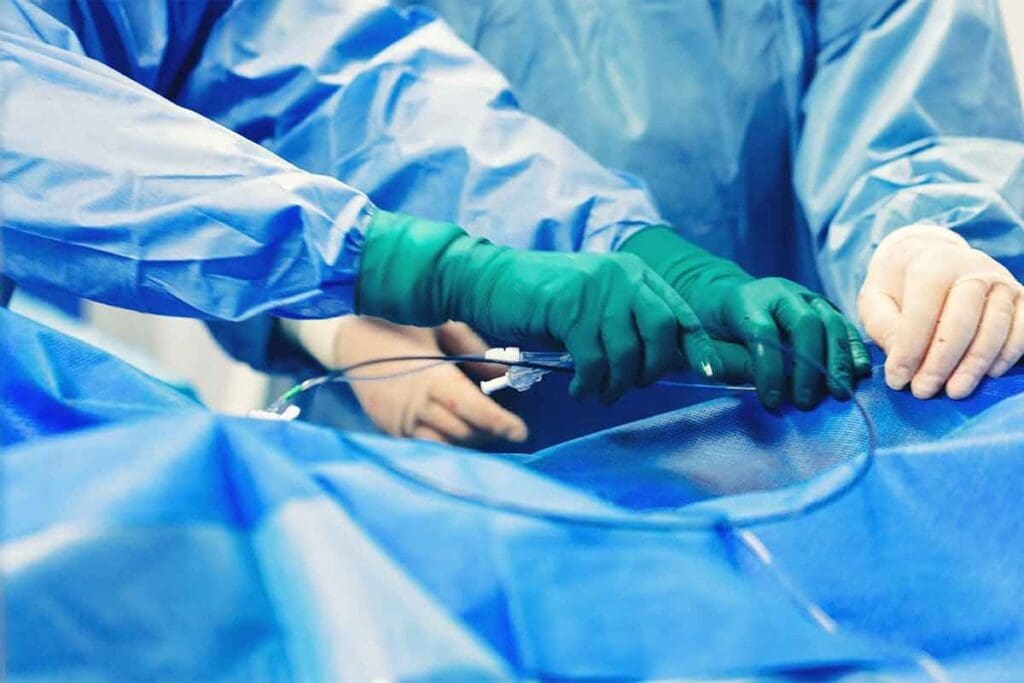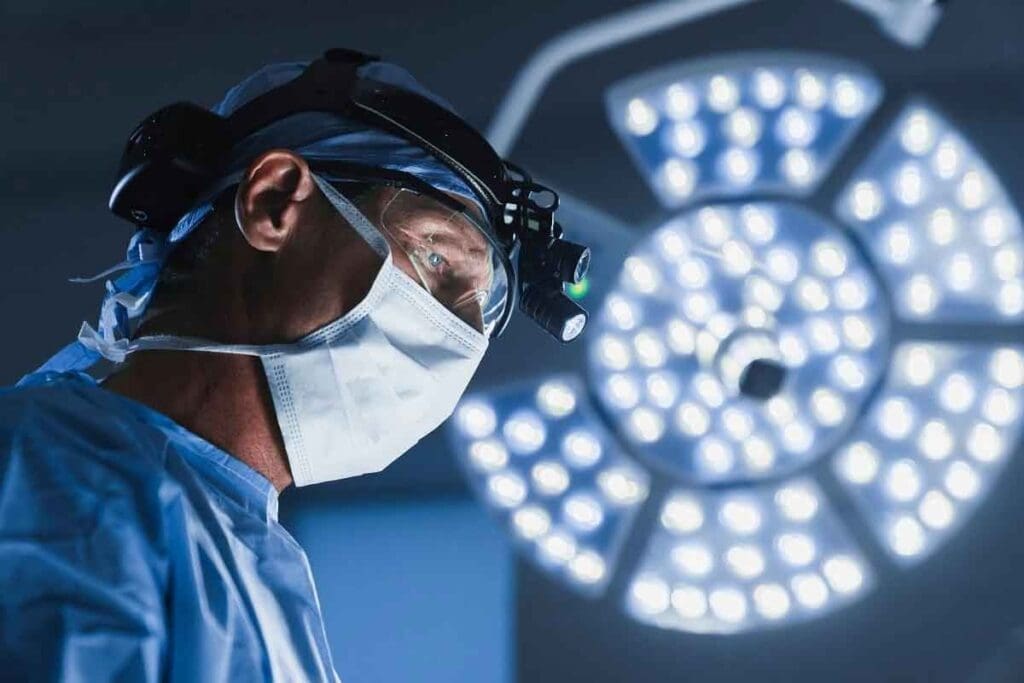Last Updated on November 26, 2025 by Bilal Hasdemir

Coronary Artery Bypass Graft (CABG) surgery is a big deal. It’s an artery operation that helps get blood flowing to the heart again.
This surgery fixes blocked coronary arteries by using healthy ones. It makes sure the heart gets the blood it needs.
CABG is mainly done to fix blocked arteries. These blockages can lead to heart attacks or symptoms that feel like one.
Knowing what definition of CABG means helps patients understand its importance. It’s a life-saving surgery.
Key Takeaways
- CABG surgery restores blood flow to the heart by bypassing blocked coronary arteries.
- The procedure uses healthy blood vessels to improve blood flow to the heart muscle.
- CABG is a major surgery performed to alleviate blockages in the coronary arteries.
- Understanding CABG is key for patients to see its importance.
- CABG is also known as heart bypass surgery.
The Fundamentals of CABG Surgery

CABG, or heart bypass surgery, is a life-saving operation for those with coronary artery disease. It aims to improve blood flow to the heart by bypassing blocked arteries.
Definition and Medical Abbreviation
CABG means Coronary Artery Bypass Grafting. It’s a surgery where a healthy blood vessel is used to bypass a blocked artery. This improves blood flow to the heart muscle. The term “heart bypass graft” is often used the same way as CABG.
Why It’s Called “Cabbage Surgery”
CABG is sometimes called “cabbage surgery.” The reason for this name is unclear. It might be because of the surgery’s complexity or a mispronunciation of “CABG.” But it’s important to know CABG is a serious and effective surgery.
Is CABG Considered Open Heart Surgery?
Yes, CABG is open heart surgery. The chest is opened, and the heart is directly accessed. This makes CABG a type of open heart surgery, whether the heart is stopped or kept beating.
| Aspect | Description |
| Definition | CABG is a surgical procedure to improve blood flow to the heart. |
| Medical Abbreviation | CABG stands for Coronary Artery Bypass Grafting. |
| Type of Surgery | Open heart surgery. |
Coronary Artery Disease: The Primary Reason for CABG

Coronary artery disease is the main reason for CABG surgery. It happens when blood flow to the heart is reduced. This is due to blocked arteries caused by plaque buildup.
Understanding Coronary Blockages
Coronary blockages are mainly caused by atherosclerosis. This is when plaque builds up in the coronary arteries. The plaque is made of fat, cholesterol, and calcium.
Over time, this buildup can narrow or block the arteries. This reduces blood flow to the heart.
When Medical Therapy Isn’t Sufficient
Medical therapy is often the first treatment for coronary artery disease. But, it’s not enough for everyone. When blockages are severe or medical therapy fails, CABG surgery is considered.
Candidates for CABG Surgery
Patients with severe coronary artery disease who haven’t responded to other treatments are candidates for CABG. The decision to have CABG surgery depends on several factors. These include the disease’s extent, the patient’s health, and symptoms like angina or shortness of breath.
| Characteristics | Candidates for CABG | Not Candidates for CABG |
| Severity of Coronary Artery Disease | Severe blockages in multiple arteries | Mild or no blockages |
| Response to Medical Therapy | Not responding or insufficient response | Well-managed with medication and lifestyle changes |
| Overall Health | Suitable for surgery based on health status | Significant comorbidities that pose surgical risks |
In conclusion, coronary artery disease is a serious condition. CABG surgery is a key treatment for severe cases. It helps restore blood flow to the heart and improves quality of life.
Bypass Graft Meaning: Creating New Pathways for Blood Flow
Bypass grafting is key in CABG surgery. It aims to fix blood flow to the heart hit by coronary artery disease.
The procedure of coronary artery bypass graft uses grafts for new blood flow paths. A surgeon takes a healthy blood vessel, often from the chest or leg. They then attach the ends below the blocked artery, making a new path for blood.
The Purpose of Coronary Bypass Grafts
The main goal of coronary bypass grafts is to boost blood flow to the heart. These grafts bypass blocked or narrowed coronary arteries. This ensures the heart gets the oxygen and nutrients it needs.
This is vital for those with coronary artery disease. It helps reduce symptoms like angina and shortness of breath.
How Bypass Grafts Restore Circulation
Bypass grafts create a detour around blocked coronary arteries. This detour lets blood flow freely to the heart muscle. It reduces heart damage risk and boosts cardiac function.
The grafts come from other body parts, like the saphenous vein from the leg or the internal mammary artery from the chest.
The Significance of Multiple Bypasses
Some patients need multiple bypass grafts for several blocked arteries. Multiple bypasses are significant because they fully address coronary artery disease. They ensure all affected heart areas get better blood flow.
This is very helpful for those with complex or widespread coronary artery disease.
Understanding bypass grafts in CABG surgery helps patients see the procedure’s complexity and importance. It’s a life-saving step.
CABG as a Major Artery Operation: Surgical Approach
CABG surgery is a major artery operation that needs a lot of skill. It starts with getting to the heart. This complex procedure aims to improve blood flow to the heart.
Accessing the Heart Through Sternotomy
The first step is to open the chest to get to the heart. A long incision is made down the center of the chest. The breastbone is then opened to expose the heart for grafting.
Sternotomy is a big deal. It’s a major cut that lets surgeons directly access the heart.
Vessel Harvesting Techniques
Harvesting vessels is another key part of CABG surgery. Grafts are taken from the legs or chest. The choice depends on the patient’s health and the surgery’s needs.
- The saphenous vein is often used because of its size and length.
- The internal mammary artery is chosen for its long-term success rate.
- Other arteries, like the radial artery, might also be used.
Connecting the Grafts to Coronary Arteries
After getting the grafts, they are attached to the coronary arteries. This step is critical for bypassing blockages and restoring blood flow.
The success of CABG surgery relies on how well the grafts are connected. Surgeons must make sure the grafts are securely attached to avoid problems.
In short, CABG is a complex surgery. It involves getting to the heart, taking vessels for grafts, and attaching them to the coronary arteries. Knowing how CABG is done helps us understand its importance and complexity.
Types of Heart Grafts Used in CABG
In CABG surgery, picking the right graft is key. Surgeons have many options to choose from.
Grafts in CABG usually come from arteries or veins in the body. The left internal mammary artery (LIMA) and the saphenous vein are the most common sources.
Left Internal Mammary Artery (LIMA)
The LIMA is the top choice for CABG. It has high success rates and improves survival chances.
- High long-term patency rates
- Improved patient survival
- Reduced risk of future cardiac events
Saphenous Vein Grafts
Saphenous vein grafts are also popular for CABG. They’re often used with LIMA grafts.
The saphenous vein comes from the leg. It’s a good choice because it’s easy to get and works well for CABG.
Radial Artery and Other Conduits
Other grafts like the radial artery are used too. The radial artery is from the arm.
It’s chosen for patients needing more grafts or with certain body shapes.
Procedure for CABG Surgery: Step-by-Step
Learning about CABG surgery can ease worries for patients and their families. The procedure for CABG surgery has many important steps. These range from getting ready to the actual surgery.
Preoperative Preparation
Before CABG surgery, patients need to prepare. They must change their activities, diet, and medicines as told by their doctor. Preoperative preparation is key to reduce risks and make the surgery go smoothly.
A top cardiothoracic surgeon, says, “Getting ready before surgery is very important. Patients must listen to their doctor’s advice to stay healthy before the surgery.”
“The better prepared a patient is, the better the outcome will be,”
he stresses.
Anesthesia and Surgical Setup
On surgery day, patients get anesthesia to feel no pain and sleep. The team then gets ready for the surgery. They connect the patient to a heart-lung machine to keep blood flowing and oxygen levels up. Anesthesia and surgical setup are critical for a successful surgery.
The Bypass Procedure Itself
CABG surgery creates bypasses to the coronary arteries to get blood to the heart again. The team picks the grafts, often using the left internal mammary artery or saphenous vein. They then attach these grafts to the coronary arteries. The bypass procedure itself needs great skill and care.
- The team makes a chest incision to reach the heart.
- The patient is connected to a heart-lung machine.
- The grafts are taken and made ready for use.
- The grafts are then attached to the coronary arteries to bypass blockages.
Knowing the procedure for CABG surgery helps patients prepare for the surgery and recovery.
On-Pump vs. Off-Pump CABG Techniques
It’s important to know the difference between on-pump and off-pump CABG techniques. CABG, or coronary artery bypass grafting, helps improve blood flow to the heart. It does this by bypassing blocked or partially blocked arteries.
Traditional CABG with Heart-Lung Machine
Traditional CABG, or on-pump CABG, uses a heart-lung machine. This machine circulates blood and oxygenates the body during surgery. It makes it easier for the surgeon to work on a heart that’s not moving.
Advantages of On-Pump CABG:
- Provides a clear and bloodless area for the surgeon to work
- Is good for complex or multiple bypass grafts
Beating Heart Surgery (Off-Pump CABG)
Off-pump CABG, or beating heart surgery, doesn’t use a heart-lung machine. Instead, the surgeon uses special equipment to keep the heart area stable. This lets the rest of the heart keep beating.
Benefits of Off-Pump CABG:
- Reduces risks from the heart-lung machine
- May cause less body trauma and faster recovery
Comparing Outcomes Between Approaches
Both on-pump and off-pump CABG have their own benefits and drawbacks. The choice depends on the patient’s condition, the surgeon’s skill, and other factors.
| Aspect | On-Pump CABG | Off-Pump CABG |
| Use of Heart-Lung Machine | Yes | No |
| Heart Condition During Surgery | Stopped | Beating |
| Potential Recovery Time | Generally longer | Potentially shorter |
In conclusion, both on-pump and off-pump CABG are good options for patients needing coronary artery bypass grafting. The choice depends on the patient’s needs and the surgeon’s approach.
CABG Nursing: Specialized Care Throughout the Journey
Nurses have a big role in CABG (Coronary Artery Bypass Grafting) surgery. They help before, during, and after the surgery. Nurses teach patients before surgery and watch over them afterward.
Preoperative Patient Education
Teaching patients before surgery is key in CABG nursing. Nurses explain what will happen before, during, and after surgery. They talk about the risks and benefits of CABG. This helps patients feel less scared and follow instructions better.
- Explaining the surgical process and what to expect during recovery
- Discussing the importance of preoperative testing and preparation
- Providing guidance on managing medications before surgery
Intraoperative Nursing Support
Nurses help a lot during CABG surgery. They keep the area clean, handle tools, and watch the patient’s health.
Key responsibilities during CABG surgery include:
- Assisting the anesthesiologist with patient monitoring
- Maintaining accurate records of the surgical process
- Ensuring all necessary equipment is available and functioning properly
Postoperative Monitoring and Care
After surgery, nurses watch patients closely for any problems. They also help manage pain and teach patients and their families about care after surgery.
Postoperative nursing care involves:
- Monitoring vital signs and watching for signs of complications
- Managing pain and discomfort through medication and other interventions
- Educating patients on wound care, activity levels, and follow-up appointments
Nurses play a big part in making sure patients do well after CABG. They help improve patient outcomes and make care better overall.
Recovery and Rehabilitation After CABG
CABG recovery is more than just healing from surgery. It’s about getting stronger and improving heart health. This process involves medical care, physical therapy, and making lifestyle changes.
Hospital Stay Timeline
After CABG surgery, patients usually spend a few days in the ICU. They stay in the hospital for 7 to 10 days. This depends on their health and if any complications arise.
In the hospital, patients start moving early. This helps prevent blood clots and improves blood flow. Moving early is a key part of recovery.
Physical Therapy and Activity Progression
Physical therapy is very important after CABG. Patients start with simple exercises like arm and leg movements. These exercises help improve blood flow and strengthen muscles.
As patients get better, they do more challenging activities. It’s important to follow a structured plan for recovery. This plan includes:
- Breathing exercises to improve lung function
- Gradual increase in walking distance and intensity
- Strengthening exercises for the upper and lower body
Cardiac Rehabilitation Programs
Cardiac rehabilitation is a key part of recovery. It includes exercise, education on heart-healthy living, and stress counseling. These programs help patients recover from CABG and improve heart health.
A typical cardiac rehabilitation program lasts several months. It includes:
| Program Component | Description | Benefits |
| Exercise Training | Supervised exercise sessions tailored to the patient’s condition | Improves cardiovascular fitness, reduces symptoms |
| Education | Information on diet, exercise, and stress management | Empowers patients to manage their condition |
| Counseling | Support for quitting smoking, managing stress, and improving mental health | Enhances overall well-being and reduces risk factors |
Combining hospital care, physical therapy, and cardiac rehabilitation leads to successful recovery after CABG. It’s a journey that requires dedication. But, the results can greatly improve life quality and heart health.
Risks, Complications, and Success Rates
It’s important to know the risks and complications of CABG before surgery. CABG is a major surgery for heart disease. It’s a big decision that needs careful thought about its risks and benefits.
Potential Short-Term Complications
Short-term problems after CABG include bleeding, infection, and irregular heartbeats. These can happen during or right after surgery. Close monitoring in the ICU helps catch and treat these issues early.
Other short-term risks are kidney disease and stroke. These risks are higher for people with diabetes, high blood pressure, or kidney disease.
Long-Term Considerations
Long-term, CABG might lead to graft failure and more heart disease. Changing your lifestyle and taking medicine can help manage these risks.
Think about how CABG affects your quality of life. Most people see big improvements in how they feel and what they can do. But, they also need ongoing care and might need more surgeries later.
Statistical Outcomes and Survival Rates
CABG can greatly improve survival for some patients, like those with complex heart disease. Survival rates depend on the patient’s health, how bad their heart disease is, and other health issues.
Research shows that many patients live 10 to 20 years or more after CABG. It’s key to keep up with regular check-ups to watch the health of the graft and your heart.
Conclusion: Living Well After Coronary Artery Bypass Grafting
After coronary artery bypass graft (CABG) surgery, many patients see big improvements in their life quality. CABG surgery is more than just the operation. It’s about the recovery and managing heart health for the long run.
It’s key to manage conditions like diabetes, high blood pressure, and cholesterol well after CABG. Research shows that those who manage these conditions well do better in the long run. At 10 years after surgery, many patients stay in good physical and mental shape. Some even stay symptom-free for years.
To get the most out of CABG surgery, living a heart-healthy lifestyle is vital. This means eating right, exercising regularly, and managing stress. By sticking to these habits and following doctor’s advice, people can really benefit from their CABG surgery. They can enjoy a better quality of life.
FAQ
What does CABG stand for?
CABG stands for Coronary Artery Bypass Grafting. It’s a surgery to improve blood flow to the heart.
What is CABG surgery?
CABG surgery, or coronary artery bypass grafting, creates new paths for blood to the heart. It bypasses blocked or narrowed arteries.
Why is CABG referred to as “cabbage surgery”?
CABG is called “cabbage surgery” because of how “CABG” sounds like “cabbage.”
Is CABG considered open heart surgery?
Yes, CABG is open-heart surgery. It involves opening the chest to reach the heart.
What is coronary artery disease, and how does it relate to CABG?
Coronary artery disease narrows or blocks arteries due to plaque buildup. CABG treats this by improving blood flow to the heart.
What are the different types of grafts used in CABG?
CABG uses grafts like the left internal mammary artery (LIMA), saphenous vein grafts, and radial artery grafts.
What is the difference between on-pump and off-pump CABG?
On-pump CABG uses a heart-lung machine. Off-pump CABG, or beating heart surgery, doesn’t use this machine.
What is the role of nursing care in CABG?
Nursing care is key in CABG. It includes education before surgery, support during, and monitoring after.
What is the typical recovery process after CABG?
Recovery after CABG includes a hospital stay, physical therapy, and activity increase. Cardiac rehab programs are often part of it too.
What are the possible risks and complications of CABG?
CABG risks include bleeding and infection short-term. Long-term, graft occlusion is a concern.
What are the success rates and statistical outcomes for CABG?
CABG has high success rates. It improves survival and quality of life for many. But, outcomes vary based on individual factors.
What lifestyle changes are recommended after CABG?
After CABG, patients should make lifestyle changes. This includes diet changes, more exercise, and quitting smoking to manage heart health.
References:
- Hillis, L. D., Smith, P. K., Anderson, J. L., Bittl, J. A., Bridges, C. R., Byrne, J. G., … & American College of Cardiology/American Heart Association Task Force on Practice Guidelines. (2012). 2011 ACCF/AHA Guideline for Coronary Artery Bypass Graft Surgery: a report of the American College of Cardiology Foundation/American Heart Association Task Force on Practice Guidelines. Circulation, 125(24), e652-e735. https://pubmed.ncbi.nlm.nih.gov/22777087/






